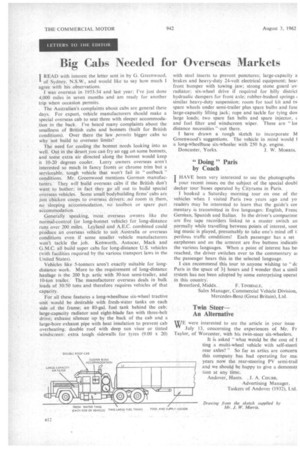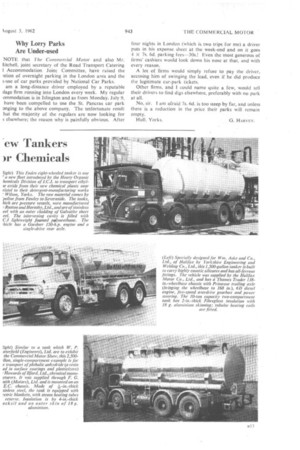Big Cabs Needed for Overseas Markets
Page 38

Page 39

If you've noticed an error in this article please click here to report it so we can fix it.
I READ with interest the letter sent in by G. Greenwood, of Sydney. N.S.W., and would like to say how much I agree with his observations.
I was overseas in 1953-54 and last year; I've just done 4,000 miles in seven months and am ready for another trip when occasion permits.
The Australian's complaints about cabs are general these days. For export, vehicle manufacturers should make a special overseas cab to seat three with sleeper accommodation in the back. I've heard many complaints about the smallness of British cabs and bonnets (built for British conditions). Over there the law permits bigger cabs so why not build to overseas limits?
The need for cooling the bonnet needs looking into as well. Out in the desert you can fry an egg on some bonnets, and some extra air directed along the bonnet would keep it 10-20 degrees cooler. Lorry owners overseas aren't interested so much in fancy fronts or chrome trim but a serviceable, tough vehicle that won't fail in " outback " conditions. Mr. Greenwood mentions German manufacturers. They will build overseas cabs if the British don't want to bother; in fact they go all out to build special overseas vehicles. Some small bodybuilding firms' cabs are just chicken coops to overseas drivers: -nd" room in them, no sleeping accommodation, no toolbox or Spare part
accommodation. .
Generally speaking, most overseas owners like the normal-control (or long-bonnet vehicle) for long-distance runs over 200 miles. Leyland and A.E.C. combined could produce an overseas vehicle to suit Australia or overseas conditions even if some smaller vehicle manufacturers won't tackle the job. Kenworth, Autocar, Mack and G.M.C. all build super cabs for long-distance U.S. vehicles (with facilities required by the various transport laws in the United States).
Vehicles like 5-tonners aren't exactly suitable for longdistance work. More to the requirement of long-distance haulage is the 200 h.p. artic with 30-ton semi-trailer, and 10-ton trailer. The manufacturer overseas deals in bulk loads of 30/50 tons and therefore requires vehicles of that capacity.
For all these features a long-wheelbase six-wheel tractive unit would be desirable with fresh-water tanks on each side of the frame; an 80-gal, fuel tank behind the cab: large-capacity radiator and eight-blade fan with three-belt drive; exhaust silencer up by the back of the cab and a large-bore exhaust pipe with heat insulation to prevent cab overheating; double roof with deep sun visor or tinted windscreen; extra tough sidewalls for tyres (9.00 x 20) with steel inserts to prevent punctures; large-capacity a brakes and heavy-duty 24-volt electrical equipment; heal front bumper with towing jaw; strong stone guard ov radiator; six-wheel drive if required for hilly district hydraulic dampers for front axle; rubber-bushed springs o similar heavy-duty suspension; room for tool kit and tv spare wheels under semi-trailer phis spare bulbs and fuse large-capacity lifting jack; rope and tackle for tying dov large loads; two spare fan belts and spare injector, c and fuel filter and windscreen wiper. These are "lot distance necessities "'out there.
I have drawn a rough sketch to incorporate M Greenwood's suggestions. The vehicle in mind would 1 a long-wheelbase six-wheeler with 250 h.p. engine.
Doncaster, Yorks. J. W. MORRIS.
" Doing " Paris by Coach .
I HAVE been very interested to see the photographs I your recent issues on the subject of the special doubl decker tour buses operated by Cityrarna in Paris. ,
I booked a Saturday morning tour on one of the vehicles when I visited Paris two years ago and yo readers may be interested to learn that the guide's cor mentarv is transmitted in five languages: English, Frenc German, Spanish and Italian. In the driver's compartme are five tape recofders linked to a master switch an normally while travelling between points of interest, soot ing music is played, presumably to take one's mind off t! perilous traffic conditions! Each passenger has a set earphones and on the armrest are five buttons indicatii the various languages. When a point of interest has be reached, the driver switches over to the commentary al the passenger hears this in the selected language.
I can recommend this tour to anyone wishing to "dc Paris in the space of 3# hours and I wonder that a simil system has not been adopted by some enterprising operat in this country.
Branford, Middx. F. TINSDALE, _
Sales Manager, Commercial Vehicle Division, Mercedes-Benz (Great Britain), Ltd.
• Twin Steer— An Alternative
wE were interested to see the article in your issue July 13, concerning the experiences of Mr. Fr Taylor, of Worcester, with his twin-steer six-wheelers. It is asked "what would be the cost of ting a multi-wheel vehicle with self-steer rear axles? " So far as artics are concern this company has had operating for ma years now the rear-steering PV semi-trail and we should be happy to give a demonstt tion at any time, Andover, Hants. J. A. CI-IURB,
Advertising Manager, Taskers of Andover (1932), Ltd.
Why Lorry Parks Are Under-used
NOTE that The Commercial Motor and also Mr. litchell, joint secretary of the Road Transport Catering
Accommodation Joint Committee, have raised the !stion of overnight parking in the London area and the t-use of car parks provided by National Car Parks.
am a long-distance driver employed by a reputable ilage firm running into London every week. My regular ommodation is in Islington and as from Monday, July 9, have been compelled to use the St. Pancras car park anging to the above company. The unfortunate result hat the majority of the regulars are now looking for 3 elsewhere; the reason why is painfully obvious. After
four nights in London (which is two trips for me) a driver puts in his expense sheet at the week-end and on it goes 4 X 7s. 6d. parking fees-30s.! Even the most generous of firms' cashiers would look down his nose at that, and with every reason.
A lot of firms would simply refuse to pay the driver, accusing him of swinging the lead, even if he did produce the legitimate car-park tickets.
Other firms, and I could name quite a few, would tell their drivers to find digs elsewhere, preferably with no park at all.
No, sir. I am afraid 7s. 6d. is too steep by far, and unless there is a reduction in the price their parks will remain empty.
Hull, Yorks. G. HARVEY.
































































































